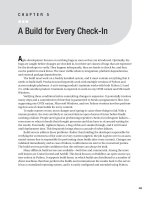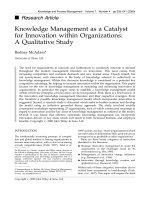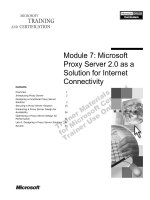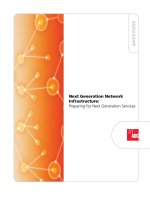A Testbed for Evaluating VoIP Service
Bạn đang xem bản rút gọn của tài liệu. Xem và tải ngay bản đầy đủ của tài liệu tại đây (170.98 KB, 9 trang )
5
A TESTBED FOR EVALUATING VoIP
SERVICE1
A new service must be prototyped and tested in a laboratory environment
before massive deployment. This allows objective and subjective evaluation
of the service in question. In addition, the findings can be used for tuning
the network operations and performance control parameters, as required for
maintaining acceptable QoS (as discussed in Chapter 4).
The testbed presented in this chapter consists of a variety of PSTN and IP
domain network elements [1]. These elements are required to emulate PSTN
and IP networks, IP network impairments, and elements of SS7 networks like
SCP and STP. Other network elements include (a) the network timing server,
(b) software- and hardware-based IP and SIP phones, (c) analog and digital
(including ISDN BRI) circuit or PSTN phones, and (d) test equipment to
emulate and analyze single and bulk phone calls. This testbed is used for a
variety of VoIP tests and measurements, as described in Appendixes A, B, and C.
Appendix A discusses how this testbed can be used to measure call prog-
ress time in IP telephony. A multistage call setup method is proposed, and its
implementation using a set of scripts written in Hammer visual basic (HVB)
language (www.hammer.com, www.empirix.com, 2001) is described.
Appendix B presents techniques to determine the bulk-call-setup request-
handling performance of IP-PSTN GWs. To achieve this, both call burst size
and intercall burst time gap must be determined so that the call setup requests
are properly processed. These are implemented using HVB language for testing
some commercially available IP telephony GWs.
59
1 The ideas and viewpoints presented here belong solely to Bhumip Khasnabish, Massachusetts,
USA.
Finally, Appendix C shows how this testbed can be utilized to evaluate the
impact of various IP network impairments—such as delay jitter, packet loss,
and bandwidth constraints—on voice quality and transmission of DTMF
messages over an IP network. HVB language is used to implements the test
scripts.
A brief description of the testbed is presented in the next section, followed
by a detailed discussion of each of its major components. The test and mea-
surements procedures, and associated HVB scripts, are available in the respec-
tive appendixes.
DESCRIPTION OF THE TESTBED/ NETWORK CONFIGURATION
This section presents a high-level description of the network configuration used
in the testbed. The interconnection diagram is presented first, followed by a
brief description of the functionality of the major network elements of the test-
bed.
As mentioned earlier, the testbed presented in this chapter consists of a
variety of PSTN and IP domain network elements. These are the elements
needed to emulate PSTN and IP networks, IP network impairments, and ele-
ments of SS7 networks like SCP and STP. Other network elements include
(a) the network timing server, (b) software- and hardware-based IP and SIP
phones, (c) analog and digital (including ISDN BRI) circuit or PSTN phones,
and (d) test equipment to emulate and analyze single and bulk phone calls.
For emulating a PSTN network, any commercially available PBX that can
support multiple TI CAS/PRI lines and multiple types (analog, digital, ISDN
BRI, etc.) of phones can be used. However, in order to support T1- and/or
DS3-type intermachine trunks (IMTs), it may be necessary to use a captive
CLASS-5 switch like Lucent’s (www.lucent.com, 2001) 5ESS switch, Nortel’s
(www.nortelnetworks.com, 2001) DMS switch, AG Communication Systems’
(www.agcs.com, 2001) GTD-5 switch, and so on. An ISDN PBX from Madge
(www.madge.com, 2001) called Madge Access Switch 60 and a GTD-5 switch
from AG Communication Systems are used in the testbed.
An IP network can be emulated by using multiple EtherSwitches connected
via a router that can be programmed to introduce various types of network
impairments. For example, NIST-Net ( />2001) and Shunra’s (www.shunra.com, 2001) cloud or storm product can be
used to introduce IP-layer impairments in a controlled fashion. We use NIST-
Net in the testbed described in this chapter.
To emulate the elements of SS7 network elements like SCP and STP, various
types of equipment can be used. These include Tekelec’s (www.tekelec.com,
2001) MGTS, Eagle’s signal transfer point (STP), Inet’s (www.inetinc.com,
2001) test equipment, and so on. We use a small STP from Tekelec in our test-
bed to emulate SS7 network elements, and both MGTS and Inet’s spectrum as
SS7 test equipment.
60
A TESTBED FOR EVALUATING VoIP SERVICE
Any general-purpose server running the network time protocols (NTPs)
(IETF’s RFC 1305/1119, RFC 2030, RFC 867/8, etc.) can be used as the IP
domain network time server (NTS). For example, TrueTime’s (www.truetime.
net, 2001, www.truetime.com, 2001) NTS can be used in the testbed. Without
proper synchronization of the asynchronously operating IP-PSTN GWs and
other IP domain network elements like routers and SIP or IP phones, voice
quality and service reliability cannot be assured.
The traditional PSTN switch suppliers such as Lucent (www.lucent.com,
2001), Nortel (www.nortelnetworks.com, 2001), and Siemens (www.siemens.
com, 2001) manufacture ISDN BRI and analog and digital phones. We use the
BRI phones from Lucent and Siemens, and digital and analog phones from
Nortel. IP and SIP phones from a number of suppliers including Pingtel, Sie-
mens, Cisco, Ploycom, and 3Com (e.g., www.pingtel.com, www.siemens.com,
www.cisco.com, www.ploycom.com, www.3com.com, 2001) can be used in the
testbed described in this chapter.
For emulating PSTN and IP-based telephone calls for tests and measure-
ments, any one or more of the following types of test equipment can be used:
Radvision’s (www.radvision.com, 2001) test equipment, Hammer’s (www.
hammer.com or www.empirix.com, 2001) IT, Agilent’s (www.agilent.com,
2001) VQT, Spirent’s (www.spirentcom.com, 2001) Abacus test system, Amer-
itec’s (www.ameritec.com, 2001) call generation products such as Crescendo/
Niagara, Catapult’s (www.catapult.com, 2001) DCT2000, IPNetFusion’s
EAST product (www.ipnetfusion.com/east.htm, 2001), and Inet’s spectrum.
Hammer’s IT, IPNetFusion’s EAST, and Inet’s spectrum testers are used in the
testbed presented in this chapter.
The network configuration diagram of the testbed is shown in Figure 5-1.
The Hammer tester is used for generating bulk emulated PSTN or circuit
domain phone calls and for analyzing emulated black (or PSTN) phone to
black phone calls. This includes measuring the answer time, the response
time at various stages of call progress, and the time required to hear the ring-
back tone at the call-originating side. The version of the Hammer tester used
in our lab can support a maximum of six T1 lines to the Madge Access
Switch.
The analog and ISDN BRI phones can be used to verify the essentials of
call progress and to measure audio quality via human perception. Call prog-
ress verification includes hearing the generation of appropriate tones—such as
a string of DMTF digits, dial tone, and ring-back tone—or a play-out of an
appropriate interactive voice response (IVR) message by a human listener.
The Madge Access Switch 60 is a small ISDN PBX or a CLASS-6 PSTN
central o‰ce (CO) switch. It provides one or more T1-CAS or T1-PRI con-
nections to the PSTN side interfaces(s) of the IP-PSTN GWs under test. In
addition, a set of ISDN BRI phones can be directly connected to it. Currently,
it has two 8-port BRI cards and several ports to support T1 connections. The
BRI cards support eight BRI phones (ISDN 8510T) from Lucent, a set of
fax machines and analog phones through Diva ISDN modems, and two BRI
DESCRIPTION OF THE TESTBED/NETWORK CONFIGURATION
61
phones (optiSet NI-1200S) from Siemens. Any of Lucent’s BRI phones can
support up to 10 calls or connections.
The two 24-port EtherSwitches and the IP network impairment emulator,
a PC-based simple router, comprise the Intranet of the testbed. The Ether-
Switches provide connectivity to the IP side interfaces of the IP-PSTN GWs (or
VoIP GWs) under test.
The VoIP gateway A (GW-A) and gateway B (GW-B) are the near-end
(or call-originating) and far-end (call-terminating) GWs. Usually GW-A and
GW-B are connected to two di¤erent subnets, which are interconnected via the
simple PC-based router mentioned above. However, if necessary, it is also
possible to connect the two GWs using the same subnet as well, that is, to
connect both GWs to the same EtherSwitch. Depending on the type of link
interface supported on the PSTN side, an IP-PSTN GW (GW-A, GW-B, etc.)
could be either a line-side, trunk-side, or residential GW.
Line-side GWs usually support multiple T1 (CAS or PRI) lines for con-
nectivity to the PSTN network. Trunk-side GWs usually support multiple
T1- and/or T3-type intermachine trunks (IMTs) for connectivity to the PSTN
network. Residential GWs usually support one (rarely more than one) T1 or
Figure 5-1 Block diagram of a VoIP testbed. The softswitch contains various VoIP
CC functions, such as, H.323 GK, MGCP/H.248 MGC, and SIP servers for registra-
tion, redirect and proxy functions, and may contain the SG and others. The SG can be
implemented in a physically separate network element (NE) as well. Clustering or hier-
archical interconnections can be used to interconnect the layers of the softswitch. The
global positioning system (GPS) antenna attached to the NTS extracts the clock infor-
mation from a globally synchronized time source and delivers the timing information to
all of the IP-based network elements. The IP phones are most likely to be SIP phones.
62
A TESTBED FOR EVALUATING VoIP SERVICE
digital subscriber line (DSL) line–based connectivity to a CLASS-5 central
o‰ce switch.
The capabilities of the IP-PSTN GWs are continuously evolving, since the
standardization committees and manufacturers are trying to make these devices
at least as reliable, available, and capable as the corresponding devices in the
PSTN networks. In addition to the IETF and ITU-T websites (www.ietf.org,
www.itu.int, 2001), one can find up-to-date information on these devices at the
following websites: www.msforum.org, www.softswitch.org, www.pulver.com/
von.com, and www.itmag.com.
In general, the softswitch element, which contains the H.323 GK and
other call control–related functions, performs registration, administration/
authentication, and status (RAS) monitoring functions when a call establish-
ment request arrives. If implemented, it can also maintain the call detail record
(CDR) files. A scaled-down version of a softswitch supporting H.323 GK
functions can run on a WindowsNT server and can be connected to the same
subnet to which GW-A is connected. Note that the softswitch can be consid-
ered a more sophisticated version of the GK. It performs all of the required
GK functions; supports H.323-v.x GWs, Internet protocol device control
(IPDC; see www.l3.com for details), SIP servers, MGCP, Megaco/H.248
devices, and their interworking; and may also support, directly or indirectly,
the functions of an SS7 SG. The SS7 SG is a device (server) that provides only a
signaling interworking function between the SS7 [2] network and the call con-
troller (CC) functional block defined above. In October 2000, IETF’s signaling
transmission (SigTran) working group released the stream control transmis-
sion protocol (SCTP, RFC 2960) for reliable and secure transmission of PSTN
signaling and transaction (SS7 messages like ISUP and TCAP) over IP. Work
is also in progress to support adaptation of SS7 MTP level 3 and MTP level 2
messages (M3UA and M2UA) for transmission over IP.
The Inet SS7 tester (www.inetinc.com, 2001) supports a variety of interfaces
including V.35, BRI, RS-449, DS0, and DS1 for connections to an SS7 net-
work. It can emulate the SS7 signal transfer point (STP) and service switching
and control points (SSP and SCP). Inet can be used to monitor the flow of SS7
messages for a preset group of originating point codes (OPCs) and destination
point codes (DPCs). It can be also used to generate SS7 ISUP messages for
setting up and terminating PSTN calls, either repetitively or in bulk.
PSTN EMULATION
For emulating a CO switch of the PSTN network, we use the Madge Access
Switch 60 (www.madge.com, 2001) and a CLASS-5 switch such as a GTD-5
switch (see www.agcs.com for details). The Madge switch can accommodate a
maximum of six 4- or 8-port cards, with 4 ports in one card reserved for local/
remote configuration, network, and timing management. The remaining ports
PSTN EMULATION
63









